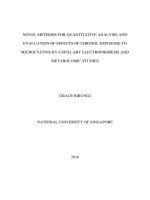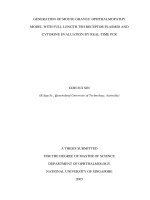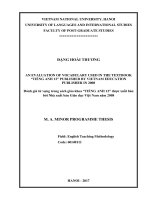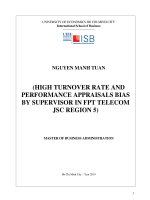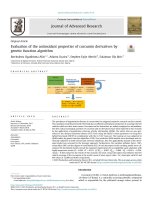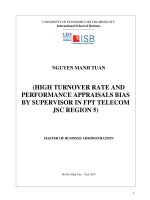Internshipportfolio microteaching evaluation by supervisor
Bạn đang xem bản rút gọn của tài liệu. Xem và tải ngay bản đầy đủ của tài liệu tại đây (606.75 KB, 19 trang )
<span class="text_page_counter">Trang 1</span><div class="page_container" data-page="1">
VIETNAM NATIONALUNIVERSITY - HO CHI MINH CITY UNIVERSITY OF SOCIAL SCIENCES AND HUMANITIES
<b>FACULTY OF ENGLISH LINGUISTICS & LITERATURE </b>
</div><span class="text_page_counter">Trang 2</span><div class="page_container" data-page="2"><small>ii </small>
<b>TABLE OF CONTENTS </b>
<small>[C4] XÁC NHẬN SINH VIÊN THAM GIA ĐÁNH GIÁ THAO GIẢNG </small> <b><small>Error! Bookmark not defined. </small></b>
</div><span class="text_page_counter">Trang 3</span><div class="page_container" data-page="3"><b>FINAL EVALUATION BY SUPERVISOR </b>
Student’s name: Châu Hảo Lan Student Code: 2067010118 Supervisor’s name: Dr.Cao Thị Phương Dung Group number: 2
<b>Grading: </b>
<b>No. ASSESSMENTS (A) & CHECKLISTS (C) Score Note </b>
2 <b><sup>A2: MICROTEACHING EVALUATION BY </sup></b>
<b>Supervisor’s signature over full name </b>
<small>VIETNAM NATIONAL UNIVERSITY-HO CHI MINH CITY UNIVERSITY OF SOCIAL SCIENCES AND HUMANITIES </small>
<b><small>FACULTY OF ENGLISH LINGUISTICS & LITERATURE </small></b>
<small>--- </small>
</div><span class="text_page_counter">Trang 7</span><div class="page_container" data-page="7"><b>[A3] REFLECTION PAPER </b>
Student’s name: Châu Hảo Lan Student Code: 2067010118 Supervisor’s name: Cao Thị Phương Dung Group number: 2
During the internship and evaluation, I learned a variety of valuable lessons that I have never forgotten, as a student undergraduate English major. I received amazing, special time experience in English teaching, especially performance of a standard teacher, classroom management and preparing lesson plans in the teaching profession. The participants received a lot of useful information and strong motivation for teaching English. Indeed, observers and teacher feedbacks, both formal and informal, are very helpful for student teachers.
Firstly, as an observer, I participated in two classes of B1 level (Reading and writing class of Vân Anh teacher & Listening and Speaking of Tấn Thịnh teacher). Through the way of teaching, the way of imparting knowledge from both teachers, I felt the love of the profession, the passion. I can learn a lot from the teachers' teaching experience, and the contents of the lessons were very practical and highly applicable. It’s so important that teachers should be fully patient and supportive when interacting with students. On the other hand, both teachers arranged lessons logically within the time limit. The two lessons were good, smooth and very interesting.
Secondly, during the observation and teaching preparation, I realized that there are many parts to a lesson plan, so the teacher must divide and balance stage and time, neither superfluous nor lacking. Smart teachers should design activities that integrate four language skills and incorporate a variety of activities to cater to different learning styles (visual, auditory, and kinesthetic). According to knowing students’ objectives and background, teachers choose to teach methods, strategies, techniques and suitable approaches for
<small>VIETNAM NATIONAL UNIVERSITY-HO CHI MINH CITY UNIVERSITY OF SOCIAL SCIENCES AND HUMANITIES </small>
<b><small>FACULTY OF ENGLISH LINGUISTICS & LITERATURE </small></b>
<small>--- </small>
</div><span class="text_page_counter">Trang 8</span><div class="page_container" data-page="8">learners. The teacher should establish clear objectives, study the textbook to know the structure of the lesson plan activities and find authentic materials to help the teaching process and appeal to learners with an exciting, attractive atmosphere. In addition, lesson planning is important for classroom management. Advanced, effective lesson planning also minimizes the need for discipline and allows teachers to make the most of their time with students.
Next, microteaching gives us opportunities to practice individual skills in a short lesson, forming parts of our teaching professional competencies in the future. In this part, although I was excited with a lot of positive energy and enthusiasm, I still had some mistakes when the students in class were too noisy; and I lost control of my emotions. While I was teaching, some students as peer evaluators were late, laughing and pointing at me. That affected my concentration. I even mispronounced the word “determine” and my teacher realized it. That is the reason why my teacher said that I didn't have very good control of the class. My instructor also commented that I should emphasize tones and practice more to improve the final sounds, intonation, language use to attract attention. However, my positive aspects of teaching were giving bonus marks to encourage students’ engagement, fluency and interacting well with learners. While-reading section was my presentation, the goals and objectives of the lesson were suitable for students' level, strategy, skimming and scanning were used to provide techniques for learners. My instructions were commented not clear. I ought to make sure all my students understood the questions before asking them to answer.
Furthermore, my goal of this part is to remind and reinforce useful techniques and recall valuable strategies in reading comprehension that learners use. My group applied the PPP method (Presentation, Practice, Production) and reading aloud for ESL/EFL teaching methodology. Besides, it’s worth noting that our instructor helped us effectively with lesson plan adjustment, which’s highly applicable to saving time and having successful microteaching. I am really appreciative of her sincere and frank feedback. Additionally, I should have eye contact with students more instead of looking at the screen or looking down.
After receiving experience and enthusiastic instruction throughout the internship and evaluating, we were given the chance to put our knowledge into microteaching the real mini-class and I recognize my strengths and weaknesses through comments from both my teacher
(instructor) and observers. Methods and approaches in language teaching are selected depending on the aims and goals of the teaching course /program. The more carefully
</div><span class="text_page_counter">Trang 9</span><div class="page_container" data-page="9">prepared, clear and thoughtful the lesson plan, the more it saves more time and creates confidence for teachers. The teacher should consider whether the amount of knowledge is not too large and arrange it into suitable stages so that the learners can absorb and remember quickly. Moreover, I could improve my knowledge of appropriate use of pairing work, group work or individual during each activity, moving and interacting effectively with students during lesson. In addition, using a variety of media (video, audio, web materials, etc.) is essential to provide information effectively and reduce tediousness.
During the process of microteaching, I received enthusiastic support from my instructor, my group mates and even the teachers of the English Linguistics and Literature faculty. I feel so joyful and warm when thinking about graduation day. Therefore, I tried to do my best to complete the lesson plan and prepare as best as possible for my teaching session. So I practiced teaching whenever possible, in front of all the mirrors at home and at work during lunchtime. I hope all my efforts and those of the whole team will have good results.
In conclusion, through the course of studying English at the English Linguistics and Literature department, day by day, receiving input from my teachers, I gained valuable, interesting insights. I can clearly see my progress in using English not only at work but also in life. I am more confident when writing emails to customers, communicating with foreign colleagues, and traveling. If there is a suggestion to improve the internship program, I think the school could give us a little more time, so we will have better preparation and achieve better results. Due to the fact that we are students who work and learn, our time for studying is limited. Finally, I would like to sincerely thank all my teachers from the English Linguistics and Literature faculty. I feel grateful for whatever I have received here. In the future, whether I follow the teaching job or not, I will still cherish the beautiful time I had at Ho Chi Minh City University Of Social Sciences and Humanities.
</div><span class="text_page_counter">Trang 11</span><div class="page_container" data-page="11"><b>CLASS OBSERVATION REPORT </b>
<b>Student’s name: Châu Hảo Lan ... </b> Age : 22 -35 Level : Intermediate (B1) Required material: Williams, J. (2017).21st Century Communication 2: Listening, speaking, and critical thinking. Cengage Learning. Professionalism Policy: Participants are expected to be well-prepared and take an active role in class discussions and work collaboratively with their peers. <b>DESCRIPTION OF STUDENTS: </b> Those students are at an intermediate level in English. They have been learning together from the previous courses. They have a basic understanding of English, and they are on the way to developing four skills: listening, speaking, reading and writing. In addition, <small>VIETNAM NATIONAL UNIVERSITY-HO CHI MINH CITY UNIVERSITY OF SOCIAL SCIENCES AND HUMANITIES </small> <b><small>FACULTY OF ENGLISH LINGUISTICS & LITERATURE </small></b>
</div><span class="text_page_counter">Trang 12</span><div class="page_container" data-page="12">students from diverse backgrounds, various jobs, which can enrich classroom discussion covered and show positive responses to cultural diversity.
<b>AIMS AND OBJECTIVES </b>
<b>AIMS: </b>
+ To improve students’ speaking skills to produce spoken texts at B1 level and communicate more fluently.
+ To enable students to understand spoken language, including diverse accents and dialects, and demonstrate listening skills (note-taking, locating main ideas, and details, etc.)
+ To promote students’ confidence in speaking and listening in English.
<b>OBJECTIVES: By the end of the lesson, students will be able to: </b>
+ Sharpen their listening skills via conversation, lectures, panel discussion by note-taking, locating main ideas, and details.
+Extend their vocabulary and use it appropriately in conversations.
+Express their feelings, ideas, and thoughts in English, even if they make mistakes, communication is an opportunity to practice listening and speaking effectively.
+Practice pairing work, group work to prepare for future academic discussions.
<b>DESCRIPTION OF ACTIVITIES </b>
<b>Speaking </b>
Activities :
+ Discuss question 2 on page 4 of the textbook (Do you have a list of things you’d like to do before you die ? Have you ever told anyone what’s on the list ? Why, or why not ? ) +Part C on page 5 (Read and listen to the statements with words from the class discussion you will hear. Guess the meaning of each bold word. Then match each word to its
definition.)
</div><span class="text_page_counter">Trang 13</span><div class="page_container" data-page="13">After pair worked, the teacher invited 2 volunteers to share their views on the topic with classmates. Then, the teacher asked students to ask questions presenters who had spoken their opinions. Students were very excited and interacted with each other positively, the classroom atmosphere became exciting. Next, the teacher invited students to comment on the speech of 2 volunteers. Following that, the teacher gave his evaluation and instructed students to outline simple but effective tactics to practice speaking English more fluently and confidently. In particular, he suggested that students who want to make a convincing point of view need to give more true evidence and students should pay more attention to
<b>pronunciation and stress, and intonation practice. </b>
<b>Listening </b>
Activities :
+ Task E page 6 : Listen for main ideas
+ Task F page 7 : Listen for examples
+ Task G page 8 : Listen for details
The teacher played the audio and students concentrated on listening and understanding the basic content of the lesson and doing the tasks (choose the best phrase to complete each main idea, use the outline to complete the notes, choose the best word or phrase to complete each statement). After the second time of audio playing, the students identify the answers. Then the teacher asks students to write their answers on the board. Finally, the teacher played back the audio for the whole class to check again the right answers.
<i><b>DISCUSSION OF METHODS AND TECHNIQUES USED (appropriacy, effectiveness, </b></i>
<i><b>practicality, etc …) </b></i>
The teacher designs pairs and group activities aimed at improving students’ communication, speaking and listening skills. The teacher uses Communicative Language Teaching (CLT) in speaking teaching, and Bottom-up & Top-down processes in listening. Through listening lessons, students also know how to grab the keywords of the text and take notes quickly. In the speaking section, the teacher offered prompt guidance and feedback to help students build communication skills and confidence. Student’s signature
</div><span class="text_page_counter">Trang 14</span><div class="page_container" data-page="14"><b>CLASS OBSERVATION REPORT </b>
<b>Student’s name: Châu Hảo Lan ... </b> <i>Writing: Folse, K.S., Muchmore-Vokoun, A., & Solomon, E.V.(2020). Great writing 2: Great paragraphs (5th ed). Cengage Learning. Professionalism Policy: Participants are expected to use target vocabulary items related to </i> topics covered in the textbook, understand paragraph types, practice writing paragraphs, <small>VIETNAM NATIONAL UNIVERSITY-HO CHI MINH CITY UNIVERSITY OF SOCIAL SCIENCES AND HUMANITIES </small> <b><small>FACULTY OF ENGLISH LINGUISTICS & LITERATURE </small></b>
</div><span class="text_page_counter">Trang 15</span><div class="page_container" data-page="15">improve transferable skills and be well-prepared and take an active role in class discussions and work collaboratively with their peers.
<b>DESCRIPTION OF STUDENTS: </b>
Those students are at intermediate level of English language. They have been learning together from the previous courses. They have basic understanding of English and they are on the way developing four skills: listening, speaking, reading and writing. In addition, students from diverse experience backgrounds, various jobs, which can enrich classroom discussion about topic covered and show positive responses to cultural diversity.
<b>AIMS AND OBJECTIVES </b>
+ To enrich students’ vocabulary and reinforce their knowledge of grammar rules + To boost students’ ability at reading and writing in English
<b>OBJECTIVES: </b>At the end of the lesson:
+ Students could be able to apply reading strategies, skimming and scanning techniques in reading comprehension.
+Students could be able to write well-organized paragraphs with appropriate use of language to prepare for essays in the future.
+Students will be able to use a broader vocabulary and apply grammatical structures in reading and writing.
<b>DESCRIPTION OF ACTIVITIES </b>
<b>Reading </b>
<b>Activities: </b>
</div><span class="text_page_counter">Trang 16</span><div class="page_container" data-page="16">+ Remind concepts of skimming, scanning, topic sentence, and main ideas, supporting ideas.
+Practice in Reading 1A: Sweet Love (Unit 1, pp. 7-20)
The teacher asked the students to read the text and find the main idea, topic sentence of each paragraph. The teacher encouraged students to share their answers and invited them to expand on the techniques they used to find the answers.
<b>Writing </b>
Activities:
+ Four Features of a Paragraph
+ Analyzing a paragraph; analyzing the features of paragraphs
+ Building better sentences
The teacher reminded the structure of a paragraph; analyzed the features of paragraphs with the whole class. The teacher told us four features of a paragraph; the way to build better sentences. Then, students did the exercises.
<i><b>DISCUSSION OF METHODS AND TECHNIQUES USED (appropriacy, effectiveness, </b></i>
<i><b>practicality, etc …) </b></i>
The teacher used the Integrated Skills Approach. In my opinion, the teacher applied the method integrates reading and writing into a single activity or lesson. Moreover, the teacher motivates students to respond to questions and express their views (according to memorize vocabulary items related to the topics covered in the textbook). The teacher assigns increasingly difficult tasks to both challenge students and boost engaging learning experiences.
<b>Student’s signature </b>
</div>

